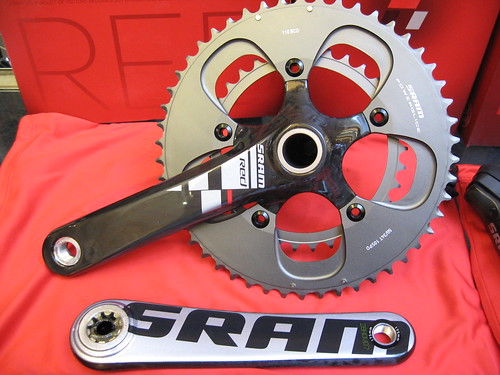

TT Shifters

No question the aesthetics of these shifters is top-notch. One nice feature not apparent from the pictures is that there are fewer parts to these than a Dura-Ace bar end shifter set. Good news for you home mechanics! Combined with the Red rear derailleur I would say the shifting is more positive than Dura-Ace: each shift is very solid. The carbon levers look great and save some weight, but I'm not sure how they'd hold up in a crash, or even accidental drop. One feature that I miss is the ability to switch to friction mode. This has come in handy more than once when shifting problems have come up mid-race or mid-ride. On the flip side, not having this extra non-essential piece is in-line with the SRAM philosophy of simplification (less parts, better durability, lower weight).
Drivetrain
Rather than belabour you with the minutia of each drivetrain piece I will just write a few words about how everything works together. Ceramic bearings have been all the rage among weight weenies and bike techies. I've never been convinced that these upgrades are worth the price tag. SRAM Red was the first grouppo to offer ceramic bearings as standard equipment. Both the external bottom bracket and rear derailleur pulleys utilize ceramic bearings. Just playing with these pieces before they were installed, I thought they were smooth, but not noticably more so than standard bearings. As soon as I started my first ride with the new stuff, I have to admit everything was smoother. Granted the Dura-Ace stuff I took off had lots of miles on it and had been raced in too many rainstorms this year, but there was a definite, noticable difference. Beyond that, the derailleurs were easy to install and adjust. As noted above, the shifting is very strong and solid. I believe the rear derailleur spring is stronger than Dura-Ace, which helps with nice crisp shifting. I think it is a toss-up for most innovative pieces between the double-tap shifters and the rear cassette. Cassettes haven't changed much since the change-over from freewheels. SRAM's approach to the Red cassette is entirely new. They start with a solid chunk of steel and do about an hours worth of material removal to come up with a hollow cassette made entirely of steel, which when nickel plated is much more durable than the titanium that Dura-Ace uses. The hollow design means the whole thing is also lighter than a Dura-Ace cassette. This is definitely my favorite piece of the tri group. Below is a picture that shows some of the cassette machining process.

Stoppers

An object in motion tends to stay in motion, therefore brake design of a top-end group has to be at or above the standards of the rest of the group. The Sram Red brakeset again betters Dura-Ace and Record by a few grams. The good news is that it doesn't do it by sacrificing stopping power like some other ultra-light aftermarket brakes. The Red brakes have a centering screw which is very important to me since I switch between race wheels and training wheels all the time (I don't believe Force and Rival have this screw?). My brakes came equipped with high-end yellow SwissStop carbon brake pads. The pads actually performed great on aluminum rims, but I got some squeal on my Zipps. More than likely this is due to me not taking the time to set proper toe-in, but I am still switching back to Zipp brake pads for Kona.
Bike Snob Aesthetics
Lastly, I consider functionality and performance as the most important criteria when selecting bikes and components. So I take it as a nice finge benefit that the SRAM Red components just look so awesome on the BMC! The color scheme is the same and BMC also uses a bold graphic design similar to what is on the Red cranks. Never hurts to look good when you're tearing it up!


Bottom Line
Sram hit a homerun with the Red group and struck some serious fear into Shimano and Sram. Still you get what you pay for. Weight-wise the Force grouppo is only about 150 grams heavier than Red. The new models of Force and Rival get trickle-down technology from Red, so other than the minor weight penalty there shouldn't be much in step-down in functionality/peformance. If you have to have the best, that is Red, but I'd have to say it is unlikely that anyone would lose a race because they were using Force and not Red!
Blowing Sunshine up..........
Whenever a sponsored athlete sings the praises of some company product, I am pretty skeptical. Fair enough, don't take my word for it. Check out a few other glowing reviews:
TestRider
PezCycling
Cycling News

